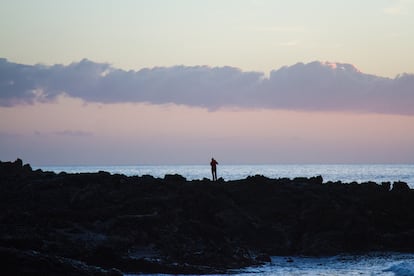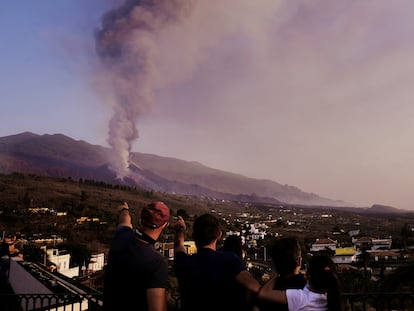How lava from the La Palma volcano turned a beloved beach into the newest territory on Earth
The platform that has been formed by the molten rock off the coast of the Spanish Canary Island has turned an attractive bay into a truly apocalyptic – and dangerous – scene

“This used to be my favorite beach.” Davinia Hernández is a waitress in the restaurant located inside one of the main hotels in Los Cancajos, the principal tourist area on the island of La Palma. “I used to go down there to get a tan, and maybe end the day in the bar up the top.”
Davinia’s favorite beach no longer exists. Los Guirres, also known as Playa Nueva, a bay that was 300 meters long, was also a preferred spot for surfers on this, one of Spain’s Canary Islands, a volcanic archipelago located in the Atlantic Ocean off the northwestern coast of Africa. But everything changed on September 28.

That day, the beach was completely buried by the tons of lava flowing down to the sea from the new volcano on La Palma, which first erupted on September 19 and since then has been spewing out molten rock at varying speeds. Now the bay is nothing more than a smoking platform of lava, measuring nearly 33 hectares in area and more than 30 meters deep. The site is being monitored to ensure that no one can approach, given the dangerous consequences that the gas emanating from the new surface could have. The newest territory on the Earth could be deadly. “It’s emitting water and hydrochloric acid, and its effects should not be underestimated,” warns María José Blanco, a volcanologist from Spain’s National Geographic Institute (IGN). The only official victim of the previous eruption on La Palma, which took place on October 26, 1971, was due to someone inhaling toxic gases in the area of Los Percheles.
“It was a wild beach,” explains Sonja, a 47-year-old resident of La Palma who is originally from Germany, speaking about Los Guirres. On Saturday she was one of the people waiting in line to be let past by the Civil Guard to enter her home in Las Manchas neighborhood – located between the municipalities of El Paso and Los Llanos de Aridane. “I could even go [to the beach] with my dog from time to time. It had maintained a wild touch, even despite the fact that they had done too much work on it.”
Stavros Meletlidis, a volcanologist, prefers not to be questioned about the new platform created by the lava in the sea. “I think it’s frivolous, given what we have up there and after so many people have lost their homes,” he says, in reference to the trail of destruction caused by the lava flow, which has covered 400 hectares of land and destroyed hundreds of buildings. Meletlidis is speaking to a dozen or so reporters from what used to be Puerto Naos, a small tourism center two kilometers away from the new platform. Since it was evacuated on September 19, due to the danger of the collapse of a ledge located behind, it looks like a post-apocalyptic scene from the TV show The Walking Dead. There are abandoned stores, deserted businesses, locked up apartments... and ash. Mountains and mountains of ash filling every nook and cranny, and piled up on the tables.
“The correct term is a lava platform,” the volcanologist explains on the walk to the beach in the area while chatting to the journalists, who are being escorted by the Civil Guard and the local police. The visit was organized by the Canary Islands regional government. “It’s a very common phenomenon when there are eruptions in the Canary Islands. In fact, right now you and I are standing on one of them, but it’s one that was created many years ago.”
A large part of the Canarian coasts, in fact, was formed from the arrival of this kind of lava tongue into the sea. “Tenerife, Fuerteventura... they are all over the place,” he explains, in reference to two of the other Canary Islands. It’s just a question of time, he adds, before this new land is used by humans.
Carlos Fernández was a common user of this beach, he explains, speaking outside the sports center in Los Llanos de Aridane, which has now been converted into a logistics center to assist people who have lost their homes or have been evacuated. But now the loss of a beach for the island is, for him, a triviality. “My in-laws,” he explains, “lost their entire house right at the start of the eruption.”
English version by Simon Hunter.
Tu suscripción se está usando en otro dispositivo
¿Quieres añadir otro usuario a tu suscripción?
Si continúas leyendo en este dispositivo, no se podrá leer en el otro.
FlechaTu suscripción se está usando en otro dispositivo y solo puedes acceder a EL PAÍS desde un dispositivo a la vez.
Si quieres compartir tu cuenta, cambia tu suscripción a la modalidad Premium, así podrás añadir otro usuario. Cada uno accederá con su propia cuenta de email, lo que os permitirá personalizar vuestra experiencia en EL PAÍS.
¿Tienes una suscripción de empresa? Accede aquí para contratar más cuentas.
En el caso de no saber quién está usando tu cuenta, te recomendamos cambiar tu contraseña aquí.
Si decides continuar compartiendo tu cuenta, este mensaje se mostrará en tu dispositivo y en el de la otra persona que está usando tu cuenta de forma indefinida, afectando a tu experiencia de lectura. Puedes consultar aquí los términos y condiciones de la suscripción digital.
More information

Volcanic eruption in La Palma: Part of cone collapses, increasing lava flow
Últimas noticias
Most viewed
- Reinhard Genzel, Nobel laureate in physics: ‘One-minute videos will never give you the truth’
- Oona Chaplin: ‘I told James Cameron that I was living in a treehouse and starting a permaculture project with a friend’
- Pablo Escobar’s hippos: A serious environmental problem, 40 years on
- Why we lost the habit of sleeping in two segments and how that changed our sense of time
- Chevy Chase, the beloved comedian who was a monster off camera: ‘Not everyone hated him, just the people who’ve worked with him’










































